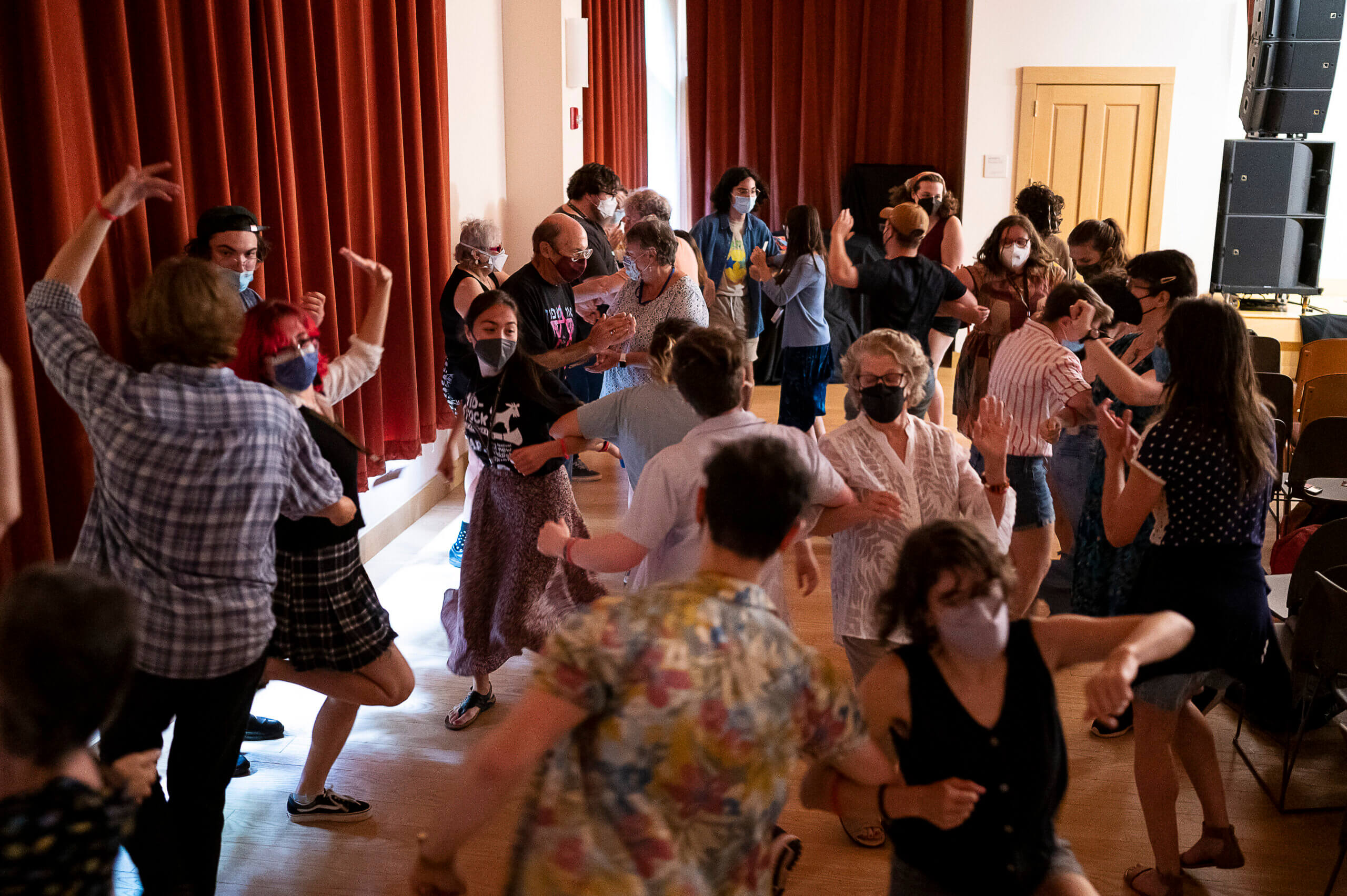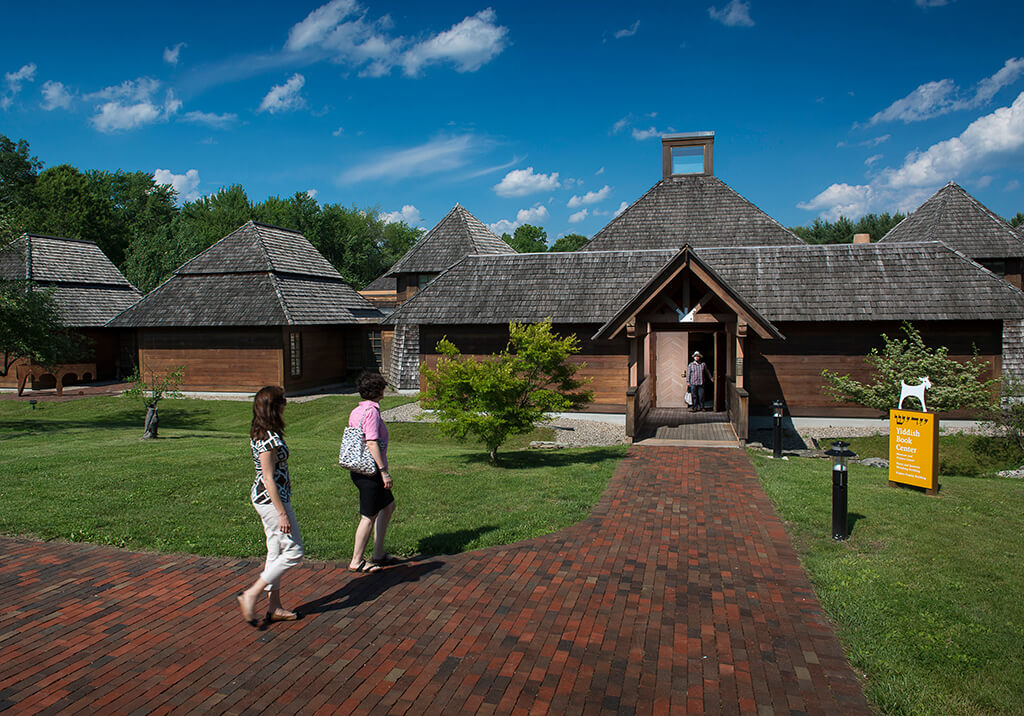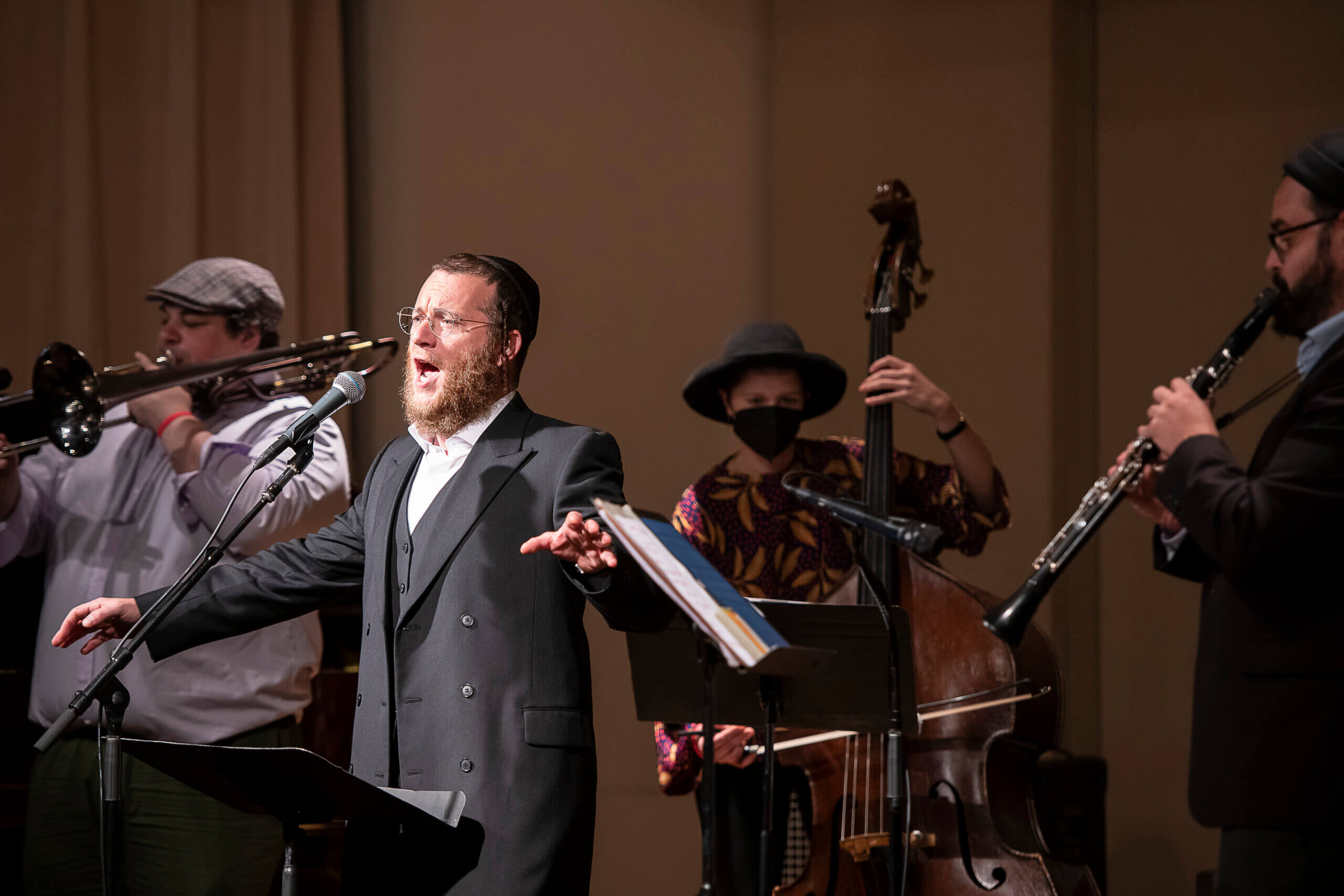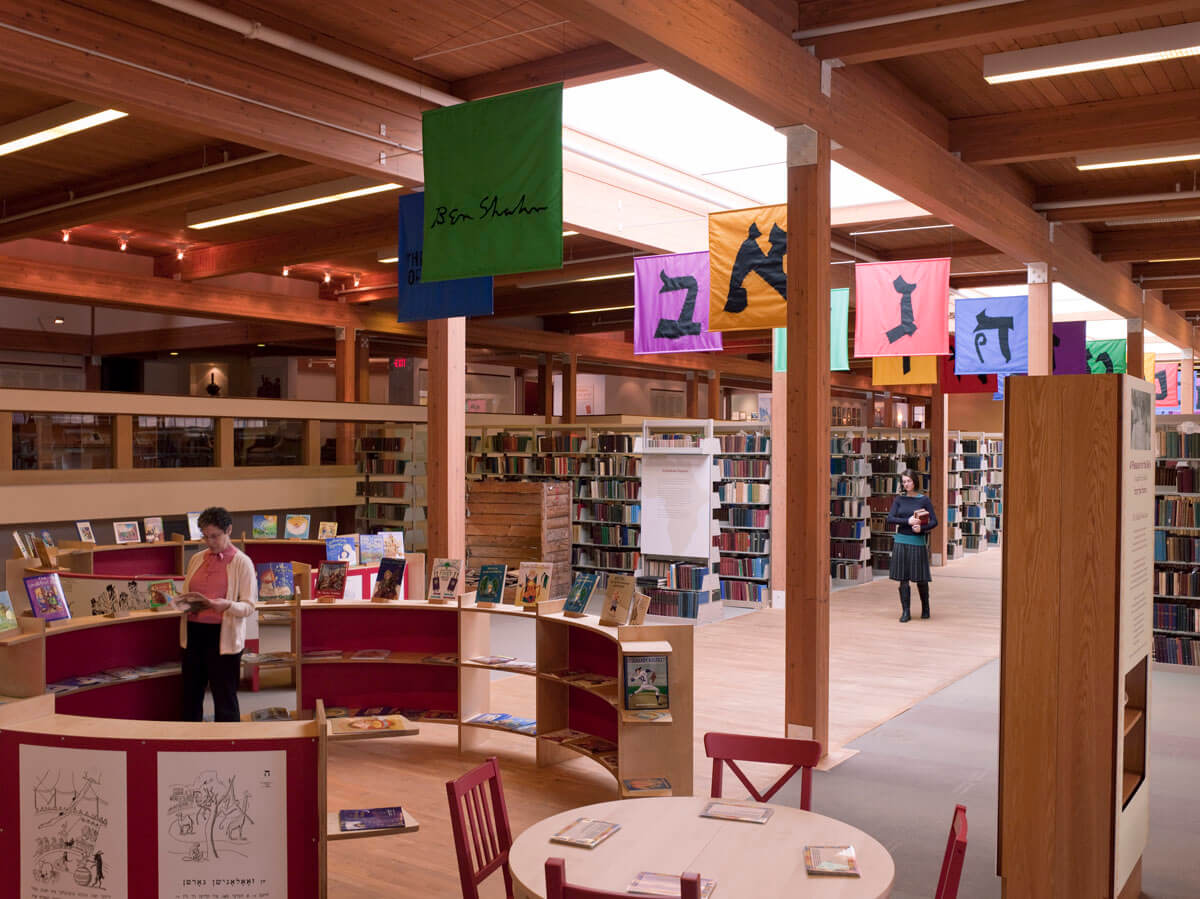At a Yiddish music festival in bucolic Massachusetts, tradition is everything — and nothing
I attended Yidstock’s 10th anniversary and found klezmer puns, folk dance flourishes and closed-toed sandals galore.

Graphic by Angelie Zaslavsky
The dance workshop was in full swing, but catastrophe was afoot: Nobody understood how to make a four-pointed star.
I’m referring to a folk dance pattern that, as one of the less competent dancers in the room, I am ill-equipped to properly describe. Suffice it to say that there are eight people standing in a “square,” and four of them are supposed to put their arms into the center and pivot clockwise (or was it counter-clockwise?), swinging each of the remaining four dancers in turn.
Things were not going well. I was aiming for an elderly man in crisp khakis, but kept ending up on the arm of a college student in a Black Sabbath T-shirt. I kept crashing into people, and I couldn’t tell who was going the wrong way. (Probably me.)
In the rare moments when I had leisure to look around, I could see the other eight-person squares were faring similarly. One couple had detached themselves entirely and were waltzing around the room on their own. Steve Weintraub, the dancer and klezmer flash mob creator leading the workshop, darted puckishly around the room, correcting steps and shouting things like, “Now promenade!” Promenading basically, is just prancing in a circle like a “Fiddler on the Roof” daughter prowling for a husband. It was a directive everyone could greet with relief.
The 50 or so masked people gathered in the barn-like hall — some young, some old, some dancing for the whole workshop, others retreating to rest on the sidelines — had signed up to learn some not-so-basic Jewish folk dances. The arrangements Weintraub created share many features with their European cousins; they’d feel familiar to anyone who has attended a square dance or watched a Jane Austen adaptation. But the klezmer accordion music provided by Lauren Brody made these dances distinctly Jewish, a taste of how our ancestors might have stepped and twirled at weddings and holidays in the old country.
When the music finally ended, participants moseyed outside to cool off, drink water, and grab lunch from a conveniently located hummus truck. They didn’t have much time to kill, because they hadn’t schlepped here just for one dance class. They were spending the whole weekend at Yidstock, an annual celebration of Yiddish music at the Yiddish Book Center’s bucolic campus in Amherst, Massachusetts.
With its low rooflines designed to mimic the feel of a European shtetl, troves of Yiddish books long out of print and archives of oral histories, the book center is oriented around the preservation of literature and culture once considered at risk of dying out. Yet Yidstock is far from championing tradition for tradition’s sake. In its endearing informality and slightly sweaty earnestness, the workshop embodied one of the weekend’s core aims: illuminating the clash between old and new customs, Jewish and non-Jewish traditions, that shaped Yiddish culture long before there were festivals commemorating it.

“People might leave a concert today and say, ‘That’s not traditional klezmer like I grew up with,’” said Seth Rogovoy, the festival’s artistic director. (Rogovoy is also a contributing editor to the Forward.) “But that klezmer you grew up with? That’s not traditional either.”
The Yiddish Book Center dates back to 1980, when Aaron Lansky, then a graduate student living in nearby Northampton, realized that American Jews, uninterested in their parents’ and grandparents’ Yiddish books, were disposing of them en masse. Lansky started a network of zamlers, or volunteer collectors, to find and recover books at risk of destruction — and soon became known as someone who would do anything to save Yiddish books.
Four decades later, the project is no longer the province of scrappy volunteers. Supported by 30,0000 volunteers, the Yiddish Book Center is one of the world’s largest repositories of Yiddish books. I opened the center’s unassuming doors to reveal a librarian’s fantasy, with colorful Yiddish banners suspended over seemingly endless rows of books. But the center is still taking in new volumes. While I was chatting with David Mazower, the book center’s editorial director, a bearded employee came over to announce that “two boxes from a zamler in the Berkshires” had just arrived.
Yidstock itself started in 2011, when Susan Bronson, the Yiddish Book Center’s executive director, was a new hire brainstorming ways to attract visitors.
“I really wanted to think about what we could do where we’d be bringing in people from all over the country, and where we could also be fostering creativity in Yiddish music,” she said in a phone interview. “And I just thought that a music festival would be a wonderful thing.”
Bronson recruited Rogovoy, a musician and critic then based in the Berkshires to put together a set list. In its first iteration, Yidstock consisted of a few concerts over the course of a day. Now, in its 10th, the festival boasts 400 and a long weekend’s-worth of activities, including film screenings, dance workshops and artist talks. Some performers, like the Klezmatics, are big names who draw festival-goers year after year. Others are comparatively new arrivals: Tsvey Brider, a songwriting duo inspired by 20th-century Jewish writers and poets, formed in 2017 and has already performed at Yidstock twice.
I trekked up from New York on the festival’s first afternoon, just in time to catch Hankus Netsky’s lecture on nigunim. Wordless devotional melodies that usually originate in Hasidic communities, nigunim often make their way into synagogues of all denominations — as evidenced by the vigorous humming along that erupted in the audience every time Netsky played a snippet. Erudite on the musical merits of nigunim, Netsky was still willing to have a little fun at their expense. Explaining one four-part nigun, which is supposed to bring the singer towards ecstatic communion with God, he quipped, “In the fourth stage, you become a disembodied spirit. How’s that for music theory?”
The lecture was supposed to prepare attendees for the festival’s first concert, performed by Hasidic cantor Yaakov Lemmer, whose performance turned out to be less sacred than schmaltzy, featuring klezmer marches, a tribute to shalashudis (the third meal of Shabbat) and something called an “alcohol medley.” Swiping through sheet music on an iPad and swigging water from a Hydro Flask, Lemmer nevertheless radiated the old-fashioned geniality of a Borscht Belt dinner show host. During the livelier numbers, Weintraub led a faction of young acolytes in improvised dances down the aisles. In the rows of audience members who didn’t care to strut their stuff, closed-toed sandals tapped the entire time.

For performers, Yidstock can be a uniquely hospitable venue for unexpected musical combinations. Anthony Russell, the singing half of the duo Tsvey Brider, recalled that for his festival debut, he sang several Yiddish poems set to pop melodies. The audience ate it up.
“The world of Yiddish text, especially poetry, goes so many places,” Russell said. “It seems unfair to confine it to a certain set of sounds.”
Netsky, the lecturer, believes that music like this, and the broader project of Yidstock, occupies an outsider position relative to the mainstream Jewish community, which he argues has never fully embraced klezmer since its revival in the 1970s. “The mainstream Jewish community almost doesn’t notice it, because it’s not it’s not about Israel, it’s not about intermarriage and it’s not about synagogues,” he said.
Yidstock doesn’t exactly feel like a renegade endeavor: The Yiddish Book Center’s tens of thousands of members, shtetl-chic interiors and well-equipped performance spaces speak to a certain degree of mainstream success, at least when it comes to fundraising. But attendees who made the pilgrimage to Massachusetts were certainly searching for experiences that everyday Jewish life doesn’t provide.
Samantha Cohen, 29, traveled to Yidstock from New York City with her parents and grandparents, provisions in tow — at lunch time the family set up a full picnic spread, complete with Coleman coolers and a gingham blanket, in the book center’s parking lot. While the Klezmatics were a big draw, Cohen said, she was most excited for the chance to practice, Yiddish, which she studied in college.
While New York is rife with Jewish music, she said, “there aren’t as many events where you get to speak [Yiddish] or listen to speakers.”
Jake Krakovsky, a theater artist from Atlanta, started studying Yiddish at the beginning of the pandemic, when the Yiddish Book Center moved its in-person classes online. Even as a beginner, he said, he realized the language “was going to be very important to me, probably for the rest of my life.”
Now, Krakovsky, 31, is a counselor at the book center’s summer Yiddish intensive, which has finally resumed in-person classes. He oversees a sizeable cohort of college and graduate students who find their way to the center — and to Yidstock — for reasons personal, academic and political.
“I see folks with a really strong interest in klezmer,” Krakovsky said. “I see folks with an interest in various aspects of Jewish history. I see folks who really want to be close to Judaism but are either turned off or alienated by the centrality of Zionism in Jewish institutions.”

One of Krakovsky’s charges is Grayson Hawthorn, 20, a Smith College student studying Yiddish to assist her Russian studies research. Hawthorn said her parents were bemused when she announced her intention to spend the summer at Yiddish camp — but then again, so was she.
“If you told me two years ago, ‘You’re going to be at a klezmer music festival and there’s going to be a lot of people who are really hyped about this,’ I would have been like, ‘What are you talking about?’” Hawthorn said.
As the folk dance workshop drew to a close, Weintraub paused to explain the origins of the figures he’d taught us. Some came from Hasidic dances, while other influences were far more modern — he cited the 1938 movie “The Dybbuk” as one inspiration.
Then he arranged all the dancers in one giant square and had each side take turns dancing to the center of the room and back. I waltzed and stomped, clasping hands and making slightly awkward eye contact with people whose names I would never learn. After an hour of stumbling through complicated steps, these came naturally — maybe because they were objectively very easy, maybe because we’d all seen “The Dybbuk,” maybe because, however much they’d evolved over the years, they were part of our history.
“We’re allowed to take chunks of things,” Weintraub said of his own approach to Jewish dance. It might actually be the most traditional thing to do.

















